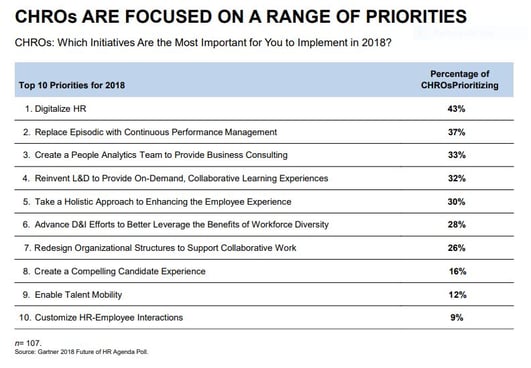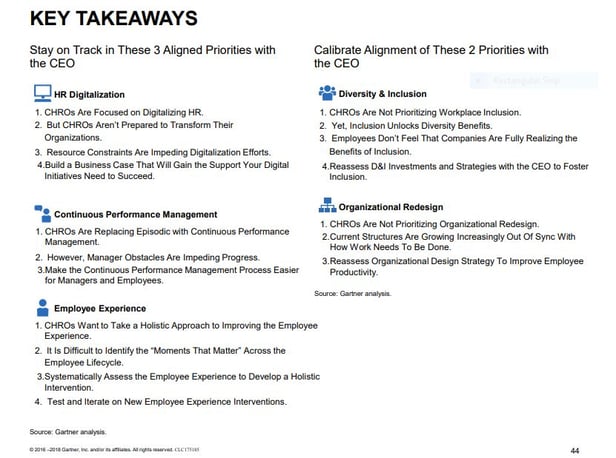I recently attended a great HR.com webinar where Brian Kropp, Group Vice President – Gartner’s HR Practice shared the results from their recently completed 2018 Gartner Annual CHRO Study.
The study provided some interesting insights:
- Digitalization and analytics are key priorities for CHRO’s
- CEO’s and CHRO’s are in alignment on the importance of digitalization, continuous performance management, and enhancing the employee experience
- CEO’s and CHRO’s differ when it comes to the importance advancing Diversity and Inclusion in their workplace, and redesigning their organizational structures to advance greater collaboration.
In the Gartner study, over 100 CHRO’s were interviewed and asked which initiatives are the most important for them. Their answers in rank order were:

The Gartner study also asked CEO’s for the rank order the same initiatives listed above by their perceived importance, and it was interesting to note the three initiatives where the CHRO and CEO were in alignment and the two important initiatives where they differed.
Alignment
- HR Digitization
- Continuous Performance Management
- Enhancing The Employee Experience
Not in Alignment
- Advancing Diversity and Inclusion Within The Organization
- Redesigning The Organization To Support Greater Collaboration

Alignment – HR Digitization
Like all other leaders in the C Suite, CHRO’s are feeling pressured and compelled to bring increased digitization into the functional area. The Gartner study reported that nearly all the CHRO’s questioned (94%) indicated that they are digitizing HR within 1 to 3 years and that they currently have an average of 5 digital initiatives currently in process.
The interesting insights that the Gartner study points out about HR digitization is:
- The CHRO rate both themselves (61%) and their organizations (71%) as not being prepared to manage their digital transformation.
- The lack of confidence is due mainly to what the CHRO’s say are poor existing IT infrastructure, a lack of adequate funding, and competing organizational priorities.
- The potential solutions to help CHRO’s succeed in digitalization are aligning the goals of HR with other departments, starting small rather than going for a massive change and learning to learn and scale successfully on the successes they achieve.
Alignment – Continuous Performance Management
Creating an effective performance management process has been a long-standing challenge for CHRO’s. While everyone agreed that there were deficiencies in the annual performance review process, a suitable replacement was difficult to find.
A dismal statistic coming out of the Gartner study was that only 4% of the CHRO’s questioned said that their organization accurately assesses performance.
The insights that Gartner provided regarding continuous performance management were:
- Improvement success hinges on manager acceptance and practice. The CHRO’s interviewed that their managers would not devote the proper amount of time to provide feedback were reluctant to have the difficult conversation and lacked the skills to provide effective feedback.
- Gartner recommended that training uniformity is implemented (manager and employee are trained together), putting a priority on quality versus quantity (the number of conversations), and building an ecosystem where employee feedback can come from others in the organization.
Alignment – Enhancing The Employee Experience
The third key initiative that both CHRO’s and CEO’s are in alignment on is finding pathways to enhancing the employee experience within their organization.
Employee Experience: Employees’ perceptions and related feelings caused by the one-off and cumulative effect of interaction with their employer’s customers, leaders, teams, processes, policies, tools and work environment.
The CHRO’s interviewed saw that their digitization initiatives would be the key driver in enhancing the employee experience in their organization. The key impact areas that the CHRO’s saw digitalization impacting are:
- Creating “Micro-Learning Platforms,” to Provide Employees with Just-In-Time, Content Chunks.
- Using Collaboration Technology to Facilitate Teamwork and Knowledge-Sharing.
- Continuously Tracking Employee Sentiment to Identify and Respond to Changes in Engagement Quickly.
- Using Gamification to Help Employees Learn and Retain New Competencies More Effectively.
- Engaging Employees in Organizational Decision-Making Through Digital Feedback Systems.
While all of these digitally drive employee experience enhancements are great, CHRO’s found them challenging to implement because they are working with fragmented systems that lack integration and there was a lack of uniformity in how to implement the changes.
Gartner recommended that CHRO’s take small steps (build a program with accumulating small wins) and putting a premium on getting engagement across the entire organization.
Not In Alignment – Advancing Diversity and Inclusion
The difference in alignment between CEO’s and CHRO’s on diversity and inclusion was the most surprising insight from the study.
CEO’s said that diversity and inclusion (D&I) was the most important initiative that they want their CHRO to be working on. Conversely, the CHRO’s said that D&I was the sixth most important initiative (29% of replies) to them. The main reason for CHRO’s giving D&I a lower ranking is that they believe that significantly changing workforce diversity is important to business outcomes.
To help build greater inclusiveness in the organization, CHRO’s need to cascade positive conflict resolution and a more open decision-making process down to the managers/frontlines. This vertical alignment is how the changes will take place.
Not In Alignment – Organizational Redesign
The second initiative that Gartner said the CHRO’s and CEO’s are not in alignment is in the importance of redesigning their organizational structures to support greater collaboration.
The difference appears to be, according to Gartner, that CHRO’s do not seem to understand or acknowledge that their present organizational structure is slowing innovation due to increased bureaucracy, a lack of system integrations, and rigid reporting structures that are not fluid enough to keep pace with the speed of the modern workplace.
Gartner strongly recommends that CHRO’s need to get deep into the organization and learn how work can get done more productively. This process cannot be done by clinically analyzing the situation from a distance. The CHRO needs to get in the trenches and fully understand the frustrations that their employees face. With this added empathy, the CHRO will be able to build new organizational designs that will align with their CEO’s desire for greater speed to market and innovation.

The Gartner CHRO provided some great insights on what is important to CHRO’s today and how they can better align themselves with their CEO’s.



